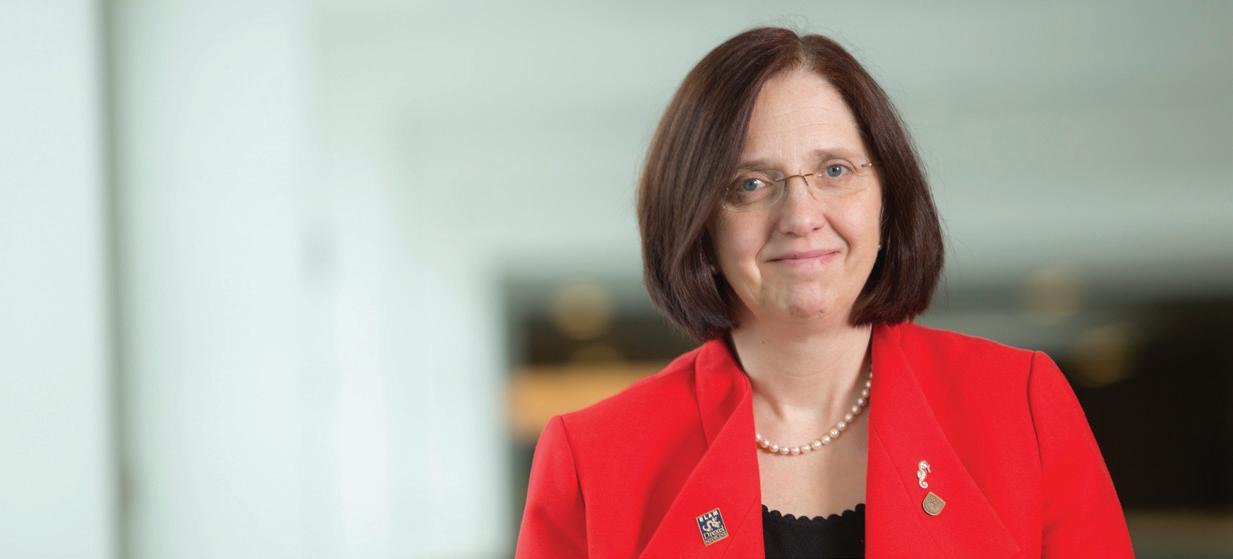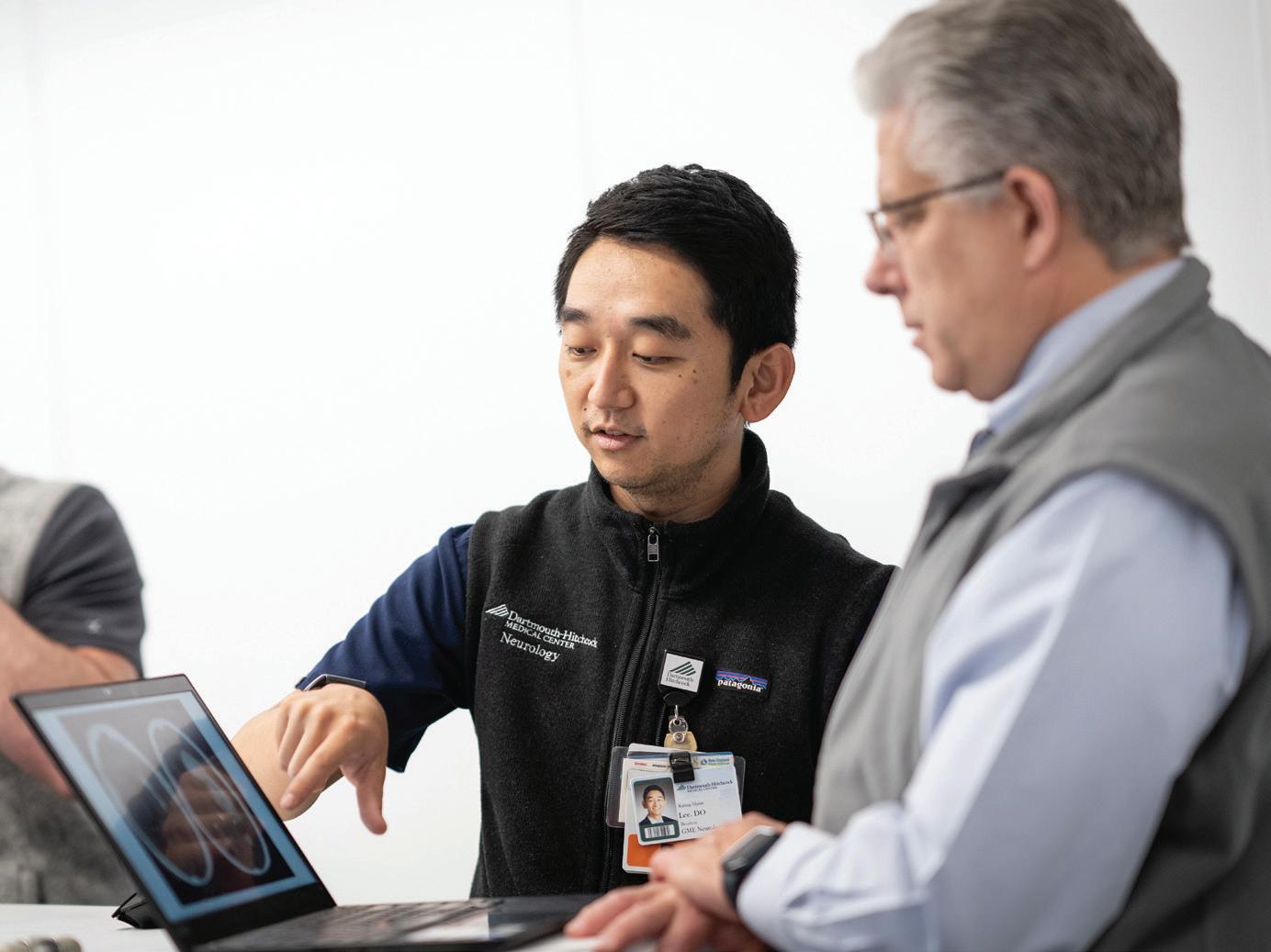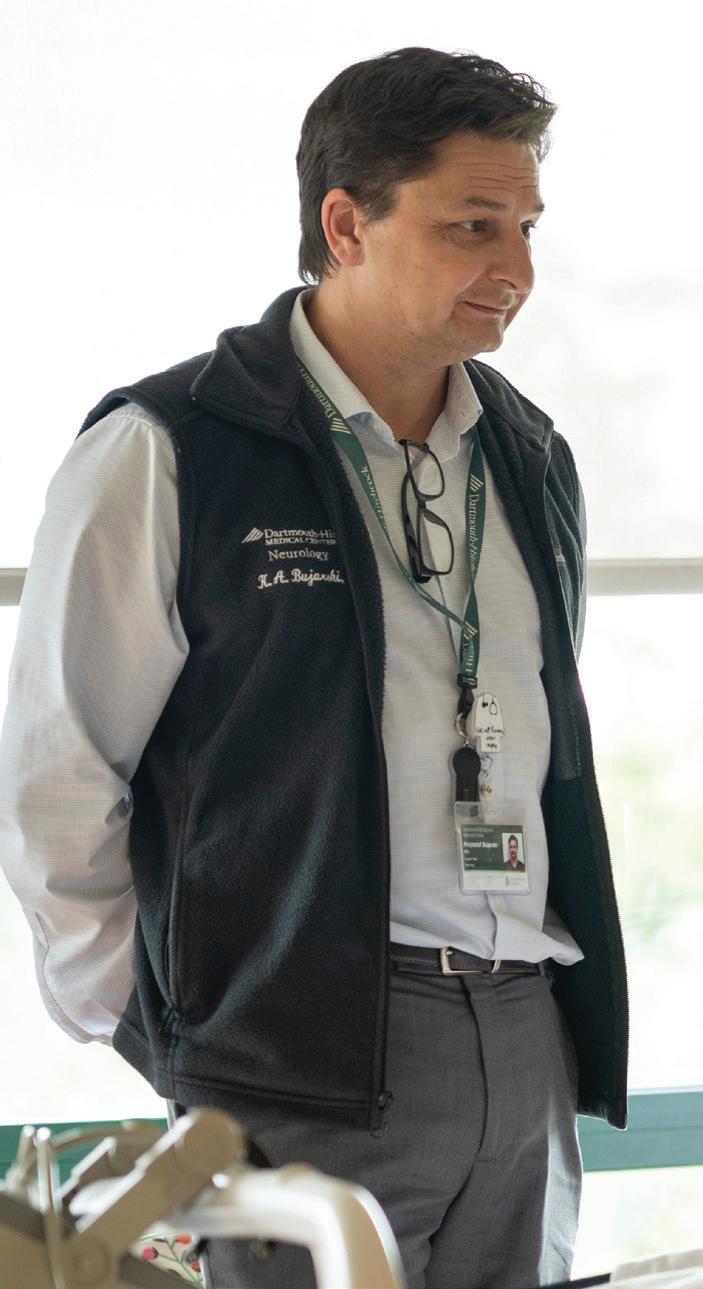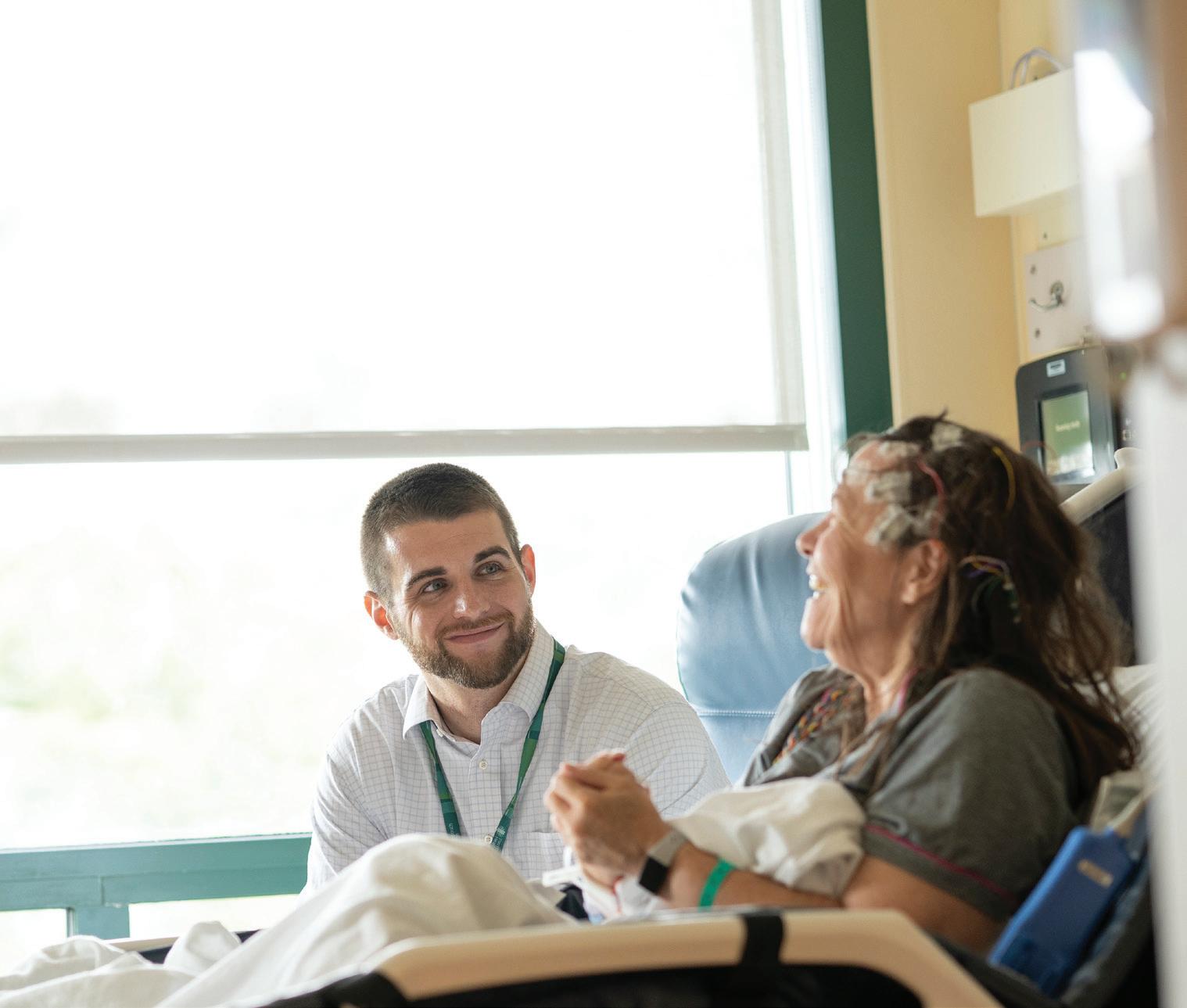RESEARCH
Long-trusted epilepsy treatment used in new ways for other neurological conditions.
page 4
EDUCATION
Residency program celebrates 50 years of training new neurologists.
page 6
PHILANTHROPY
Donor’s generous gift supports grants for high-risk research projects.
page 8
DEPARTMENT OF NEUROLOGY
SPRING 2024
DHMC recognized as a Comprehensive Stroke Center
Neurointerventionalists provide unsurpassed care for stroke patients
High-quality patient care for stroke and other neurological conditions has always been a priority for Dartmouth Health, and the Comprehensive Stroke Center certification from the Joint Commission gives that dedication a formal stamp of approval.
When Dartmouth Hitchcock Medical Center (DHMC) earned the comprehensive certification in 2022, it was one of only two hospitals with the designation in northern New England and is the only one in New Hampshire. On its way to certification, DHMC needed to fill some gaps in its neuro-critical care and neurointerventional radiology services.
“We filled those gaps to demonstrate that we are dedicated to providing high-quality, comprehensive stroke care,” says Timothy Lukovits, MD, D ’88, RES ’97, the medical director of the Cerebrovascular Disease and
Continued on page 3

Department of Neurology DARTMOUTH HITCHCOCK MEDICAL CENTER
Timothy Lukovits, MD, D ’88, RES ’97, (right) the medical director of the Cerebrovascular Disease and Stroke Program, and the rest of the Neurology team worked to fill gaps in DHMC stroke services to ensure they could provide comprehensive care.
A Message from Our Chair
Barbara Jobst, MD, RES ’00, FEL ’01
Chair, Department of Neurology, Dartmouth Hitchcock Medical Center Professor of Neurology, Geisel School of Medicine

Welcome to the first newsletter from the Department of Neurology. I’m honored to share with you our many recent accomplishments and several on the horizon.
One of our most exciting milestones in the department is the 50th anniversary of the Neurology Residency Program. Initially with only six residents in 1973, the program has grown to 20 residents at Dartmouth Hitchcock Medical Center (DHMC). We have made many significant modifications in the past several years, including turning it into a categorical program. And because we are dedicated to continually improving the training experience, we have adjusted the program to help reduce burnout, provide more uninterrupted learning time, and increase patient safety, based on feedback from our residents.
Another exciting development is DHMC’s certification as a Comprehensive Stroke Center, a designation that acknowledges the superior care we provide. To earn this certification, we hired two neurointerventionalists who, along with our longtime neuroradiologist, are capable of performing the most complex procedures to increase the likelihood of positive outcomes for our patients. This certification is particularly exceptional among medical centers in our rural region of the country.
We recently started a neurohospitalist program, which provides dedicated care for inpatients in neurology as well as teaching of dedicated faculty for inpatient neurology. The program is off to an excellent start and will grow as a subspecialty in the future.
Significant advances in intracranial brain stimulation have been made in recent decades. Researchers in our department are working to understand how intracranial brain signals could be used to program brain stimulation devices to shed light on epilepsy, memory, and consciousness. You’ll read in this newsletter about our department’s leadership in expanding the utility of intracranial electrophysiology. Intracranial EEG has been used for decades to treat people with epilepsy, but due to the risks involved, it has not been considered for other medical conditions. Our researchers are working toward safe and ethical testing of this technology for neurological and psychiatric conditions, with the hope of one day providing relief for people with these disorders.
We are grateful for the philanthropic support of alumni, current and former faculty, as well as donors who are not affiliated with Dartmouth Health—like Susan Diamond. In the 10 years since she left more than $6 million in her will to our department, the funds have supported 58 research projects conducted by clinical researchers, residents, fellows, nurses, students, and non-clinical staff. Many of these investigators have gone on to earn grants from the National Institutes of Health, the Centers for Disease Control and Prevention, and other organizations.
I’m proud of every person in this department who has made meaningful contributions to the work we are doing for our patients, our region, and the world. We hope you enjoy reading these stories. We have many more to share with you soon.
2 Department of Neurology
Continued from page 1
Stroke Center
Stroke Program at DHMC. “We have a long history of quality improvement.”
He notes that DHMC’s rural location and fewer providers make it unusual in terms of being considered comprehensive. Nevertheless, providers at DHMC can receive and treat the most complex stroke cases, thanks to the many teams working together: TeleNeurology services, emergency department, angiography, cardiology, Neuro-ICU, and the Dartmouth Hitchcock Advanced Response Team (DHART), which treats acute stroke cases in the field. And DHMC’s neurosurgeons and neuroradiologists have advanced training to perform procedures that few other providers in the region can do.
Although transferring patients to a higher level of care quickly can be a challenge, DHMC leverages its TeleNeurology service to speed up that process, which is critical when every minute counts. These highdefinition audio-visual calls allow DHMC specialists to see patients at other hospitals, and their advanced training helps them recognize and diagnose less common presentations of stroke. Then the transfer process can begin right away, reducing the “door in, door out” time.
Lukovits recalls a recent TeleNeurology call from a hospital in Keene, New Hampshire, in which the stroke patient needed to be transferred to DHMC, more than an hour away. Because Lukovits recognized the urgency of the

situation during the virtual call and recommended the transfer, he was able to begin notifying DHMC providers about what the patient would need upon arrival that might not already be in the emergency room, such as an MRI-compatible ventilator.
“I could bridge that gap with knowledge of the patient’s condition through the teleneurology call,” Lukovits says. “I could shepherd the patient from one place to another, helping to fight potential inefficiencies that come up. For example, I spoke to the patient’s husband by phone to explain the procedure and get approval in advance. If someone had to call him later when the patient arrived and couldn’t get him on the phone, that would delay things terribly.”
In addition to having a neurosurgeon and neuroradiologist on staff to perform advanced
procedures, a Comprehensive Stroke Center must also have a dedicated neurologic intensive care unit to care for patients before and after procedures, as well as superior complementary medical services, such as cardiology, palliative and hospice care, and rehabilitation.
Adrienne Moraff, MD, and David Kung, MD, are neurosurgeons at DHMC who are dual-trained in open vascular and endovascular neurosurgery of the brain and spine. DHMC partners with smaller regional hospitals to provide acute stroke intervention and aneurysm intervention with advanced procedures and surgical implants needed to improve the chance for a positive outcome.
“I’m privileged to do what I do, and I’m proud of our team here,” Moraff says. “Being able to give someone their life back makes the 2:00 am phone calls and late nights worth it.”
3 dartmouth-hitchcock.org/neurology
Lukovits (right) and the TeleNeurology team use audio-visual calls to diagnose stroke patients at regional hospitals. This service can speed the transfer process to DHMC, which increases the likelihood for positive outcomes for patients.
New ways to use trusted technology
Research on intracranial EEG expands into modulating emotional processing
While intracranial electroencephalograms (EEG) have been used for decades to help people with epilepsy, the technology has never been used to treat other medical conditions. A Dartmouth Health neurologist’s research may one day change that.
Krzysztof Bujarski, MD, the section chief of epilepsy and director of the Epilepsy Center at Dartmouth Hitchcock Medical Center, is studying whether intracranial electrical brain stimulation can be used to modulate behavior, including emotional states, to target treatments for severe cognitive and psychiatric disorders.
“Our group is focused on bringing this technology that has been available for 50 years to treat epilepsy to also treat other people in neurology and psychiatry,” Bujarski says of this technique, called neuromodulation. “We believe this technology will be revolutionary and allow us to identify targets in the brain for treatment of these disorders.”
His project, titled “Utilizing Invasive Recording and Stimulating Opportunities in Humans to Advance Neural Circuitry Understanding of Cognitive and Mental Health Disorders,” is the second study on emotional processing he has conducted as part of the Human Intracranial Electrophysiology Consortium, a group of Dartmouth Health, Geisel School of Medicine, and Dartmouth College investigators looking at other ways to use electrical brain stimulation to treat health disorders. The pilot project wrapped up in 2018, and the current study broadens the scope of the pilot to include examining how people remember emotions. The National Institutes of Health (NIH) funded both projects.
This method of evaluation and treatment of severe cognitive and mental health disorders would be used as a last resort, Bujarski explains, because intracranial

EEG involves invasive brain surgery. Although the field of neuromodulation has become much safer in recent years—more localized and minimally invasive—it still comes with significant risks.
“This would be for severely refractory cognitive and mental health problems that don’t respond to any other treatment,” he says. “We want to help provide relief to these very specific patients who have no other option.”
The current research involves patients with intractable epilepsy who are undergoing an intracranial EEG of the amygdala, a region of the brain involved in emotional processing where seizures can arise. The research, which delivers a very small electrical current to the amygdala to observe how this region of the brain region activated during emotional situations, is done with collaborators in the department of Psychology and Brain Sciences at Dartmouth College. The departments work together to advance brain function science.
“To cure seizures, we need to use these electrodes to figure out what kind of seizures someone is having and what parts of the brain they affect,” Bujarski says. “Coincidentally, we can use these electrodes at the same time to study mental health and cognitive functions. We are piggybacking our research on the intracranial EEG the person is already having for epilepsy.”
In the study, the patients who are in the hospital undergoing the intracranial EEG are shown emotionally positive,
4 Department of Neurology
Krzysztof Bujarski, MD, (left) the section chief of epilepsy and director of the Epilepsy Center at Dartmouth Hitchcock Medical Center, is researching ways to use intracranial EEG in safe and ethical ways to treat severe cognitive and psychiatric disorders.

neutral, and negative images. Low-voltage stimulation to the amygdala either activates or down-modulates parts of this emotional circuit in order to modify the person’s level of emotional response to the images. The volunteer does not feel the stimulation, and the electrical current does not damage the brain. The person is not even aware of the minimal decrease in emotional response.
“We’re not turning off their emotional systems; we’re down-regulating them—turning down the volume,” Bujarski says. “This study is trying to find out whether it’s enough to have a clinical benefit.”
This technology has not been used in the past to treat other medical disorders because physicians rely on noninvasive imaging tests, such as functional MRI and PET scans, for diagnosis. But over the past 10 years, more advanced computational techniques have allowed neu-
We believe this technology will be revolutionary and allow us to identify targets in the brain for treatment of (cognitive and psychiatric) disorders.”
Krzysztof Bujarski, MD
Director of the Epilepsy Center at Dartmouth Hitchcock Medical Center
rologists to analyze these electrical brain signals using intracranial EEG, which can reveal what is happening inside the brain with more precision. The goal of Bujarski’s study is to identify the optimal techniques to record and analyze these brain signals, with the hope of using this modality for the treatment of these mental health and cognitive disorders in the future. Neuromodulation is an area of ongoing research for the NIH at many institutions.
Looking ahead, Bujarski hopes that neuromodulation clinical trials with people who have severe cognitive or mental disorders but do not have epilepsy will be possible. These clinical trials will be challenging because these volunteers would not otherwise be having an intracranial EEG. “We want to bring safe treatment options to people with cognitive and mental health problems, and we want to do it in a responsible manner. We’re navigating the ethics of these techniques carefully.”
CLINICAL EXCELLENCE PROGRAMS & CERTIFICATIONS
Dartmouth Health has earned recognition and certifications for many of its neurology services from highly respected organizations.
Certified Treatment of Excellence (Neuromuscular)—National ALS Association
Comprehensive Stroke Center by The Joint Commission (Cerebrovascular Disease & Stroke)
Center of Excellence by the Parkinson’s Foundation (Movement)
Center of Excellence (Movement)—Huntington’s Disease Society of America
Certified National MS Society
“Partner in MS Care”
Certified Myasthenia Gravis Foundation of America
“Partner in MG Care”
APP Fellowship Accreditation
5 dartmouth-hitchcock.org/neurology
There have been lots of changes in 50 years and in the four years I’ve been here. I’m excited to see what other people in the program continue to contribute and do over the next 50 years.”
Mark Roberts, MD, RES ’23
Residency program celebrates 50 years
History reveals a growing, evolving, and successful training program
2023 marked the 50th anniversary of the Neurology Residency Program at Dartmouth Hitchcock Medical Center, one that has expanded both in depth and breadth over the past five decades. Now a categorical program, it has grown from just six residents to 20.
“I witnessed it starting,” says Jim Bernat, MD, RES ’77, emeritus professor of neurology, who started his residency training in 1973 at Mary Hitchcock Memorial Hospital, which soon became Dartmouth Hitchcock Medical Center (DHMC). “The medical center at Dartmouth Hitchcock used to be a small hospital, not big enough to support medical education other than primary internal medicine, general surgery, general pediatrics, and general OB/GYN.”
To address that problem, Alexander Reeves, MD, founder and former chief of the Section of Neurology, joined the staff in 1971 to begin developing the neurology teaching program. At the time, Dartmouth Medical School had only recently returned to MD-granting status, and there were no neurology courses, no clerkship, and no residency. In fact, Reeves was one of only three neurologists in all of New Hampshire. But within two years, when Dartmouth graduated students with MDs again, the department had both a clerkship and a residency program, which graduated its first class of residents in 1976.
Bernat was drawn into neurology thanks to Reeves’ enthusiasm, and he completed his residency in 1977 and joined the Dartmouth faculty the same year.
At the time, most residents became general neurologists. Since then, fellowship training in neurology subspecialties—stroke, headache, multiple sclerosis, neurogenetics, epilepsy, and others—has become much more common. To accommodate these changes, the department’s depth of faculty expertise has grown.
“Residents interested in studying stroke, for example, can get mentorship from our stroke faculty and attend conferences focused on stroke,” Bernat says. “Our residency program trains learners to be general neurologists, but you can’t run a proper academic department in an academic medical center without depth in major subspecialty areas. That has been a big change over my career.”
Another significant change is the switch from being a preliminary to a categorical program. Now when neurology residents are accepted at DHMC, they
6 Department of Neurology

complete their internal medicine training under the umbrella of the Department of Neurology.
“Our interns training in internal medicine felt disconnected from our program,” says Mary Feldman, DO, who initiated the change to a categorical program when she became director of the Neurology Residency Program three years ago. “Making it categorical made it more appealing for recruitment, and now interns feel more like a part of Neurology. They know us and we know them better from the beginning. They start continuity clinics as interns rather than PGY2, so they get more neurology experience and feel more prepared for neurology residency.”
Mark Roberts, MD, RES ’23, especially appreciated the support and mentorship of the Neurology faculty. Andrew “Trey” Smith III, MD, associate director of the Neurology Residency Program, established a formal mentorship program so residents would have both a research mentor and traditional mentor. Roberts notes that even though the mentorship program has grown to five residents per year, it’s still relatively small, which allows for more direct contact between residents and faculty.
“There’s an open-door policy, so we can talk to subspecialists directly,” Roberts says. His professional goal—sports neurology—is an uncommon specialty, and he emphasizes how encouraging the faculty were in helping him secure a fellowship in Michigan. “They are all very supportive with anything you wanted to do. They’ll bend over backward to help you get there.”
Faculty support extends to listening to residents about their experience in the program—and making changes when needed. Feldman helped institute several new procedures for residents: the academic half-day so
residents have protected, uninterrupted time to focus on didactics each week; a “golden weekend” where advanced practice providers cover some shifts, giving residents an extra day off and helping to prevent burnout; a night float system that creates a longer block of days for night shift work to reduce burnout, preserve residents’ circadian rhythm, and improve patient safety; and a restructured morning report where residents discuss a case in depth as an additional learning experience. The department also started a wellness initiative of nonclinical social events throughout the program to promote resident bonding and well-being.
Also part of residents’ wellness are the “reallife things,” says Shannon Darrah, the Neurology Residency Program coordinator. “There are lots of things outside residency that affect them. They can talk to me and decompress a little bit, so they can focus on their work.” (And the treats she bakes for residents’ birthdays are exquisite.)
In April 2023, the department held a reception in Boston to celebrate the residency program’s 50th anniversary. “There were lots of people from different years who didn’t know each other,” says Bernat, a member of the second class of graduating residents. “It was a good time for the old guard to meet the younger folks. There was even one person there from the first class and someone from the fourth class.”
Although Feldman says she does not foresee any major changes on the horizon for the program, everyone is eager to see what the future may bring.
“There have been lots of changes in 50 years and in the four years I’ve been here,” Roberts says. “I’m excited to see what other people in the program continue to contribute and do over the next 50 years.”
7 dartmouth-hitchcock.org/neurology
Current and former department chairs, program directors, alumni, and other guests joined the Department of Neurology in Boston in April 2023 to celebrate the 50th anniversary of the residency program.
Attendees enjoy a presentation at a Neurology research day made possible by the Diamond Endowment Fund. The fund has supported dozens of research projects and events over its 10-year history.

Catalyst for high-risk neurology research marks 10-year
anniversary
Ten years ago, the Department of Neurology received a $6.25 million gift from a generous donor who had no affiliation with Dartmouth Health—she simply believed in the importance of neurological research. Since then, that gift has advanced neurology research that otherwise might not have been supported.
Nebraska resident Susan Diamond, who died in 2013, included Dartmouth Neurology and two other academic medical centers in her will. In the decade since, Dartmouth Neurology’s Diamond Endowment Fund has provided grants to support 58 research projects in all seven major neurological disease areas. Clinical researchers and basic scientists aren’t the only people to earn funding—residents, fellows, nurses, students, and non-clinical staff have also received Diamond Endowment Fund grants for research.
Diamond grants of all amounts— from the $5,000 Mini Grants up to the $375,000 Interdisciplinary Neuroscience Grants—have spurred hundreds of thousands of dollars, even millions in some cases, of further support from organizations such as the National Institutes of Health, the ALS Association, and the Centers for Disease Control and Prevention.
“Diamond funds are catalysts to get research projects started,” explains Jim Bernat, MD, RES ’77, formerly the Louis and Ruth Frank Professor of Neuroscience at Geisel School of Medicine and a current member of the research advisory committee that oversees the research effort in neurology.
“Research projects supported by Diamond funding can be high-risk ideas, where the outcomes are important but are unlikely to be funded by other agencies,” says Jeffrey Cohen, MD, who was the department chair of neurology when the gift was received. “Many people wouldn’t have been able to get external funding without the preliminary data generated by the Diamond grant support.”
“Both senior and young investigators have become encouraged to develop their research portfolios knowing
these grants are available,” explains Lei Wang, PhD ’03, who, along with the advisory committee chaired by Vijay Thadani, MD, PhD, oversees research projects in the neurology endowment program. “We’ve had an increase in publications, and residents can attend scientific meetings with these funds. We also have more national and international collaboration thanks to this funding.”
Department chair Barbara Jobst, MD, RES ’00, FEL ’01, the Louis and Ruth Frank Professor of Neuroscience, has recently restructured the endowment program to provide separate mechanisms for physicians and PhD faculty. “Providing separate designated research funding for both clinician and translational/basic researchers is essential for creativity and advancement of our knowledge for neurological diseases,” Jobst says. “Diamond Endowment funding has helped make this possible.”
“The endowment plays a fundamental role in neurology department research that helps us meet the increasing national need to advance research in neurologic disorders and the growing demand for neurologic care,” Wang says. She hopes people with a passion for supporting research will see the difference they can make with a gift to the Diamond Endowment.
Produced by: Medical & Healthcare Advancement One Medical Center Drive, HB 7070 Lebanon, NH 03756 DHGeiselGiving.org







